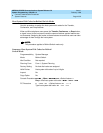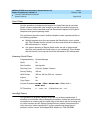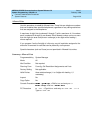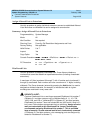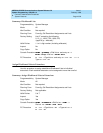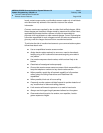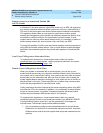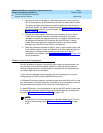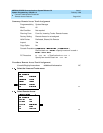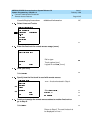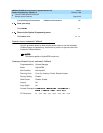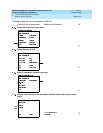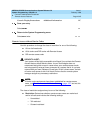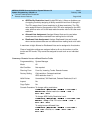
MERLIN LEGEND Communications System Release 6.0
System Programming
555-660-111
Issue 1
February 1998
Common Administrative Procedures
Page 4-340Remote Access Features
4
2. Specify that all tie trunks (that is, networked tandem tie trunks) and/or all
non-tie trunks (that is, all PRI tandem trunks) will not require barrier codes.
This does not affect calls dialing the remote access code if the trunks on
the remote system are regular, assigned remote-access trunks accessed
by remote access users on your own system. See “Remote Access without
Barrier Codes” on page 345.
3. Change the default class of restrictions, as necessary, on tie or non-tie
trunks. Any necessary restrictions should be imposed by the system
manager for a call at the originating switch. For example, extensions may
be assigned a Disallowed List to prevent 900 and 976 calls. If certain
private trunks are reserved for particular purposes, the remote system
manager may use UDP routing FRLs for this purpose.
4. Make any necessary changes to ARS in order to route remote users’ calls
to yet another system if more cost effective, or to add or absorb digits (an
area code, for example) before sending a call over a trunk that is
connected to your system. See “Automatic Route Selection” on page –363
for the procedures.
Remote Access Trunk Assignment 4
Use this procedure to assign or remove the trunks used for remote access. You
can also use this procedure to specify whether the Remote Access feature is
dedicated (always used for remote access) or shared (used for remote access
only when Night Service is activated).
Trunks used for dedicated remote access must not be assigned to ring into a
calling group or the QCC queue (Hybrid/PBX mode only).
In Release 6.0 and later systems, a remote-access caller who calls into his or her
own local system can reach extensions networked to the local system (non-local
dial plan extensions) just as on-site users of the local system can.
In Hybrid/PBX mode, if a trunk assigned to ring into the QCC queue is also used
for shared remote access, perform the procedure below before you attempt the
procedure “QCC Operator to Receive Calls” on page 4–58.
NOTE:NOTE:NOTE:
A loop-start line must be programmed for Reliable Disconnect if it is to be
used for remote access (see “Disconnect Signaling Reliability” on page
4–42).



